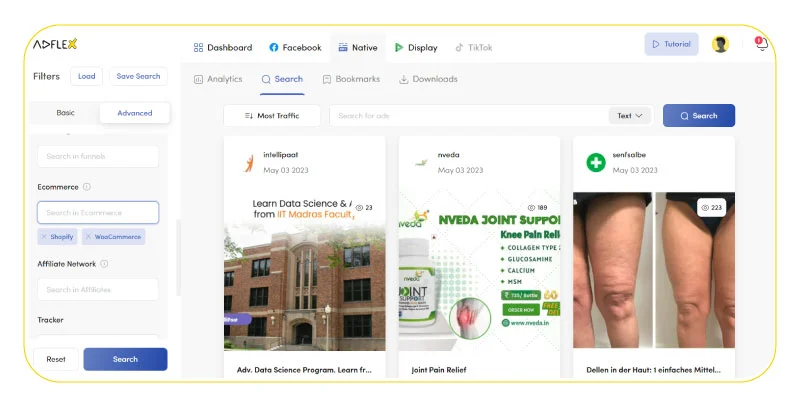In the world of ecommerce, advertising is the lifeblood of business. And with the rise of native advertising, the game has changed. As consumers become increasingly savvy and immune to traditional ads, native ads have emerged as a powerful tool to connect with potential customers.

In this article, we’re going to explore the world of native ads for ecommerce and why they’re so important. From their many benefits to best practices and successful campaigns, we’ll show you everything you need to know to take your ecommerce advertising to the next level. So let’s dive in and discover the world of native ads for ecommerce.
Native advertising for ecommerce
Native advertising for ecommerce is rapidly becoming an essential tool for businesses of all sizes, especially small ones. In fact, native advertising for small businesses can be a game-changer, allowing them to compete with bigger brands in a cost-effective way. Traditional advertising methods can be expensive and difficult to measure, leaving many small businesses at a disadvantage. But with native advertising, small businesses can create ads that blend seamlessly into their target audience’s online experience, increasing the chances of engagement and conversion.

Compared to traditional advertising, native advertising for ecommerce offers a range of benefits. For starters, native ads are less intrusive and more targeted, making them more likely to be viewed and engaged with by potential customers. They can also be more cost-effective, as they typically have a lower cost per click than traditional ads. Additionally, native ads for ecommerce can provide a more seamless user experience, which can lead to better engagement and higher conversion rates.
So, if you’re a small business owner looking to level the playing field with bigger brands, native advertising for ecommerce is definitely something to consider. By creating ads that are relevant, non-intrusive, and engaging, you can effectively reach your target audience and grow your business. In the next section, we’ll explore some of the best practices and strategies for creating successful native ads for ecommerce.
Native ad strategies for ecommerce
When it comes to native ads for ecommerce, there’s no one-size-fits-all strategy. What works for one business might not work for another. That being said, there are some best practices and strategies that can help increase the effectiveness of your native ads.
One of the most important strategies for native ads in ecommerce is to research and spy on your competition. Yes, you heard that right. By utilizing native ads spy tools like AdFlex, you can gain valuable insights into what your competitors are doing and what’s working for them. This can help you create more effective ads by understanding what resonates with your target audience and what doesn’t.

Another important strategy is to create ads that are relevant and engaging to your target audience. This means understanding their needs, interests, and pain points, and creating ads that speak directly to those things. By doing this, you can increase the chances of engagement and conversion.
Optimizing your ads for the platform and format you’re using is also crucial. For example, if you’re using native ads on social media, you’ll want to create ads that are visually appealing and optimized for mobile viewing. If you’re using native ads on a news website, you’ll want to create ads that are informative and relevant to the content on that site.
Finally, testing and optimizing your ads is key to success with native ads for ecommerce. By experimenting with different ad formats, copy, and targeting strategies, you can identify what works best for your business and refine your approach over time.
Native ad platforms for ecommerce
Choosing the right platform for your ecommerce native ads is crucial. There are a variety of native ad platforms out there, each with its own unique features, benefits, and pricing models.
One of the most popular native ad platforms for ecommerce is Google Ads. With Google Ads, you can create native ads that appear on Google search results pages, as well as on Google’s partner sites. Google Ads offers a range of targeting options and allows you to track the performance of your ads in real time.
Another popular native ad platform is Facebook Ads. With Facebook Ads, you can create native ads that appear in users’ newsfeeds or as sponsored content on Instagram. Facebook Ads allows you to target users based on a variety of factors, including demographics, interests, and behaviors.

LinkedIn Ads is another native ad platform that’s worth considering for B2B ecommerce businesses. With LinkedIn Ads, you can create native ads that appear in users’ newsfeeds or as sponsored content on LinkedIn. LinkedIn Ads allows you to target users based on job title, industry, and other factors that are relevant to B2B businesses.
Native ad platforms like Outbrain and Taboola are also popular choices for ecommerce businesses. These platforms allow you to create native ads that appear on a variety of websites, including news sites and blogs. They offer a range of targeting options and allow you to track the performance of your ads in real time.
Ultimately, the best native ad platform for your ecommerce business will depend on your goals, target audience, and budget. It’s important to do your research and choose a platform that aligns with your needs and objectives.
Native ad formats for ecommerce
When it comes to native ads for ecommerce, there are a variety of formats to choose from. Each format has its own unique strengths and can be effective for different types of ecommerce businesses.
One popular native ad format is the in-feed ad. In-feed ads appear as sponsored content within users’ social media feeds or on news websites. These ads are designed to blend in with the surrounding content, making them less obtrusive and more engaging for users. In-feed ads can be effective for ecommerce businesses looking to drive traffic to their website or promote specific products.
Another popular native ad format is the recommendation widget. Recommendation widgets appear on the side or bottom of web pages and offer users personalized product recommendations based on their browsing behavior. These ads can be effective for ecommerce businesses looking to increase sales by targeting users who have already shown an interest in their products.

Native video ads are also becoming increasingly popular for ecommerce businesses. Video ads can be used to showcase products in action or tell a brand story, making them more engaging and memorable for users. Video ads can be effective for ecommerce businesses looking to build brand awareness or promote new products.
Sponsored content is another native ad format that can be effective for ecommerce businesses. Sponsored content appears as articles or blog posts on news websites or blogs. These ads are designed to provide value to users by offering informative and engaging content that’s relevant to their interests. Sponsored content can be effective for ecommerce businesses looking to build brand awareness and establish themselves as thought leaders in their industry.
Ultimately, the best native ad format for your ecommerce business will depend on your goals, target audience, and budget. It’s important to choose a format that aligns with your objectives and offers the most value to your audience.
Native ad targeting for ecommerce
Effective targeting is key to the success of any native advertising campaign for ecommerce. By targeting the right audience, you can ensure that your ads are seen by users who are most likely to be interested in your products or services.
One effective strategy for targeting the right audience for your native ads is to use demographic data. Demographic data includes information like age, gender, location, and income level, and can be used to target users who are most likely to be interested in your products. For example, if you’re selling high-end fashion products, you might target users in higher income brackets who are interested in fashion and luxury brands.
Another effective strategy for targeting the right audience for your native ads is to use behavioral data. Behavioral data includes information like users’ browsing history, search queries, and social media activity, and can be used to target users who have shown an interest in your products or similar products. For example, if you’re selling sports equipment, you might target users who have recently searched for or purchased similar products.

Using lookalike audiences is another effective strategy for targeting the right audience for your native ads. Lookalike audiences are created by analyzing the characteristics of your existing customers and identifying users who share similar characteristics. This can be a great way to reach new users who are likely to be interested in your products but may not have discovered your brand yet.
Using native ads spy tools can also be a helpful strategy for targeting the right audience for your native ads. Native ads spy tools allow you to see what types of ads your competitors are running and what targeting strategies they’re using. This can help you identify new targeting opportunities and optimize your own targeting strategies for maximum effectiveness.
The key to effective targeting is to use a combination of different strategies and continually monitor and adjust your campaigns based on their performance. By targeting the right audience, you can ensure that your native ads are seen by users who are most likely to be interested in your products, and maximize the ROI of your advertising spend.
Conclusion
Native ads for ecommerce are a powerful tool for driving targeted traffic and sales to your online store. By using native ads, you can create ads that blend seamlessly with the content of the websites and apps where they’re displayed, leading to higher engagement and conversion rates than traditional ads. To create successful native ad campaigns for ecommerce, it’s important to focus on targeting the right audience, using effective ad formats and strategies, and choosing the right native ad platform for your needs. With the right approach and tools, native ads for ecommerce can be a highly effective way to grow your online business and drive long-term success.
FAQs
What makes native ads different from traditional ads for ecommerce?
Native ads are designed to blend in with the surrounding content, providing a more seamless and non-disruptive experience for users. Traditional ads, on the other hand, are often more obtrusive and can be seen as intrusive by users.
What are the best practices for creating native ads for ecommerce?
Best practices for creating native ads for ecommerce include using high-quality images and engaging headlines, creating ads that match the look and feel of the surrounding content, and focusing on clear calls-to-action that encourage users to take action.
How can I target the right audience for my native ads for ecommerce?
Effective targeting strategies for native ads for ecommerce include using demographic and behavioral data to target users who are most likely to be interested in your products, using lookalike audiences to reach new potential customers, and using native ads spy tools to identify new targeting opportunities.
What are the most effective native ad formats for ecommerce?
The most effective native ad formats for ecommerce include in-feed ads, sponsored content, and recommended product widgets. These formats are designed to blend seamlessly with the surrounding content and provide users with a non-disruptive and engaging experience.







 Facebook Ads Spy Tool
Facebook Ads Spy Tool TikTok Ads Spy Tool
TikTok Ads Spy Tool